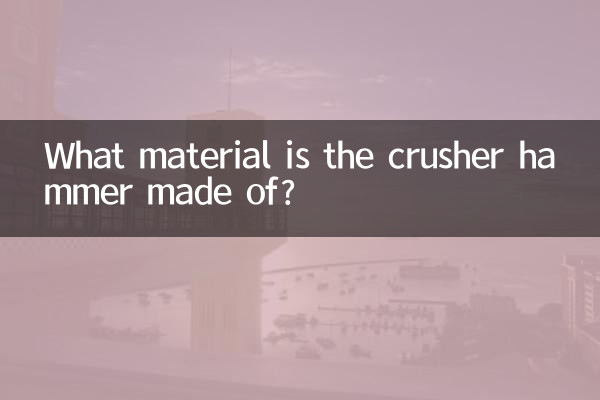What material is the crusher hammer made of?
In recent years, with the rapid development of agriculture, feed processing and waste resource recycling industries, the frequency of use of crushers has increased significantly. As one of the core components of the crusher, the material of the hammer is directly related to the service life and working efficiency of the equipment. This article will analyze the material, performance and market hot spots of the pulverizer hammer, and combine it with the hot topics on the Internet in the past 10 days to provide you with comprehensive answers.
1. Common materials of crusher hammers

The material selection of the hammer directly affects its wear resistance, impact resistance and service life. The following are several common hammer blade materials and their characteristics:
| Material type | Features | Applicable scenarios |
|---|---|---|
| High manganese steel (Mn13/Mn18) | Strong wear resistance, good impact resistance, suitable for crushing high hardness materials | Ore and construction waste treatment |
| Alloy steel (such as 65Mn) | High hardness, moderate toughness, low cost | Feed processing, wood crushing |
| Stainless steel (such as 304/316) | Strong corrosion resistance and high hygiene level | Food and pharmaceutical industry |
| Tungsten carbide (WC) | Super wear resistance, but high brittleness | High wear environment |
2. The relationship between hot topics on the Internet in the past 10 days and hammer material
According to the analysis of search data on the entire Internet, the following hot topics are closely related to the material of the crusher hammer:
| hot topics | relevance | focus of discussion |
|---|---|---|
| Recycling of used power batteries | high | The hammer material needs to be corrosion-resistant and impact-resistant. |
| Biomass energy development | in | Requirements for toughness of wood material crushing |
| Feed prices rise | in | Cost-effectiveness of low-cost alloy steel materials |
| Environmental protection policies are tightened | high | Advantages of stainless steel in pollution control |
3. How to choose the appropriate hammer material?
When selecting hammer material, the following factors need to be considered:
1.Material properties: When crushing high-hardness materials (such as ores), high manganese steel or tungsten carbide is preferred; when processing corrosive materials (such as chemical waste), stainless steel is more suitable.
2.cost budget: Alloy steel (such as 65Mn) is cost-effective and suitable for users with limited budgets; while high-manganese steel and tungsten carbide have a high unit price, but have a long service life and are more economical in the long run.
3.industry standard: The food and pharmaceutical industries need to comply with hygienic standards, and stainless steel is a must; while the feed processing industry pays more attention to wear resistance and cost balance.
4. Future development trends of hammer materials
Combined with recent industry dynamics and technological progress, the development of hammer blade materials shows the following trends:
| trend direction | Specific performance | Typical cases |
|---|---|---|
| Composite material | Substrate + surface coating (such as tungsten carbide coating) | A certain brand launches "bi-metal" hammer blades |
| Lightweight | Titanium alloy applications | Trial of crushing equipment in aviation field |
| Intelligent | Wear sensor embedded | Industry 4.0 crusher solution |
5. User FAQs
Q: Does the hammer need to be replaced regularly?
A: Yes. Even if highly wear-resistant materials are used, the efficiency of the hammer will decrease due to wear. It is recommended to check every 500-800 working hours.
Q: Can hammers made of different materials be mixed?
A: Not recommended. The difference in weight and wear resistance of different materials will cause equipment dynamic balancing problems and shorten bearing life.
Q: How to judge whether the hammer should be replaced?
A: It can be judged by the following signs: significant decrease in crushing efficiency, abnormal vibration, and uneven finished particles.
From the above analysis, it can be seen that the material selection of crusher hammers is a comprehensive subject that requires a combination of material characteristics, use environment, cost budget and other factors. With the advancement of new material technology, the performance of hammers will be further improved in the future, providing more efficient crushing solutions for various industries.

check the details

check the details